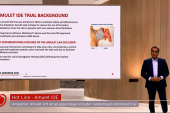Amulet, Watchman 2.5 LAAO Devices Provide Comparable 3-Year Outcomes
Extended follow-up of the Amulet IDE trial also hinted at more device-related thrombus with this earlier Watchman iteration.

BOSTON, MA—For patients with atrial fibrillation who are undergoing left atrial appendage occlusion (LAAO), the Amplatzer Amulet (Abbott) and the first-generation Watchman 2.5 (Boston Scientific) devices provide similar clinical outcomes out to 3 years, according to extended follow-up of the Amulet investigational device exemption (IDE) trial.
The findings reinforce what was seen in the primary results at 18 months, Dhanunjaya Lakkireddy, MD (Kansas City Heart Rhythm Institute and Research Foundation, Overland Park, KS), reported here at TCT 2022. Released last year, the earlier findings showed that the Amplatzer Amulet was superior to the first-generation Watchman device in terms of sealing off the LAA at 45 days, and noninferior in terms of safety at 12 months and effectiveness at 18 months. The trial was used to support US Food and Drug Administration approval, making the Amplatzer Amulet the second LAAO device available to American operators.
Now, in extended follow-up that included patients in whom an implant was attempted, “the dual-seal Amulet occluder continued to demonstrate safety and effectiveness through 3 years in the first large-scale randomized head-to-head LAAO clinical trial,” Lakkireddy said at a press conference, noting that this is the largest trial comparing two LAAO devices to date.
Moreover, “the Amulet occluder offers immediate and durable closure to reduce the risk of stroke,” Lakkireddy said. At 18 months, he added, the presence of a peridevice leak of 3 mm or greater was roughly 10% with the Amulet and 20% with the Watchman 2.5.
The message for the population at large involves “confidence in the Amulet occluder to provide immediate and prolonged closure so patients can safely remove or stay away from oral anticoagulation,” he said.
Commenting for TCTMD, Dharam Kumbhani, MD (UT Southwestern Medical Center, Dallas, TX), a member of the American College of Cardiology’s interventional section, pointed out that the initial Amulet IDE results showed a higher up-front risk of procedure-related complications with the Amplatzer Amulet, but fewer peridevice leaks. So it was important to see how that played out in terms of longer-term clinical outcomes, he said, and in that respect, “at least clinically, the devices appear to be very similar.”
He noted that this trial evaluated the Watchman 2.5 device only, not the newer Watchman FLX, so this is not a comparison of the devices most commonly used in current practice. The small SWISS-APERO trial did, however, compare the Amplatzer Amulet and Watchman FLX, similarly showing that use of the Amplatzer Amulet led to more procedural complications but fewer peridevice leaks, as seen in Amulet IDE.
But with comparable clinical outcomes at least out to 3 years, Kumbhani said, “I think device choice would probably be driven by patient- and physician-related factors.”
Amulet IDE at 3 Years
The Amulet IDE trial initially randomized 1,878 patients at 78 centers in the US and 30 elsewhere, including 1,833 (mean age about 75 years; about 60% men) in whom an implant was attempted. Of those, 1,380 completed a 3-year visit, with greater follow-up in the Amplatzer Amulet arm. That imbalance was driven, Lakkireddy said, by a higher number of deaths and withdrawals in the Watchman arm through the first 18 months of the study.
Use of oral anticoagulation was lower in patients treated with the Amplatzer Amulet versus the Watchman throughout follow-up, with significant differences at 6 months (2.8% vs 4.7%), 18 months (3.1% vs 5.6%), and 3 years (3.7% vs 7.3%; P < 0.05 for all). That could be related to a higher incidence of late device-related thrombus (DRT) in the Watchman group, Lakkireddy said, reporting that more of those patients were placed on oral anticoagulation after identification of late DRT compared with those treated with the Amplatzer Amulet (23 vs 10).
“That’s something that we have to pay attention to,” Lakkireddy said. He proposed that the difference in DRT could be related to differences in the design of the devices, as the Amplatzer Amulet has a flat disc that provides a smooth surface covering the LAA ostium.
The increase in DRT seen in the Watchman arm did not translate into worse clinical outcomes, perhaps because any DRT-related risks were mitigated by increased use oral anticoagulation, Lakkireddy suggested. There were no significant differences (P = NS for all) for any of the following events at 3 years when comparing the Amplatzer Amulet with the Watchman:
- Stroke, systemic embolism, or CV death (11.1% vs 12.7%)
- CV death (6.6% vs 8.5%)
- All-cause death (14.6% vs 17.9%)
- Ischemic stroke or systemic embolism (5.0% vs 4.6%)
- Major bleeding (16.1% vs 14.7%)
The investigators found that device-related factors, particularly peridevice leak, more commonly preceded both CV death and stroke in the Watchman arm of the trial. “Attention has to be paid to the choice of the device and how we can mitigate the risk of peridevice leaks in these patients,” Lakkireddy said. Prior research has demonstrated an association between peridevice leaks after LAAO and poorer long-term outcomes.
Choosing One Device Over Another
Commenting on the findings at the press conference, Federico Asch, MD (MedStar Health Research Institute, Washington, DC), said, “the most exciting thing here is that we have good options. We now can start to tease out which patients will benefit best from one or the other.”
But there are some factors that might favor selection of the Amplatzer Amulet over the Watchman 2.5, Lakkireddy said. Appendages with proximal lobes, large ostia, or shallow depths, for example, would be better treated with an Amplatzer Amulet, whereas for other anatomies, it’s a “toss-up” between the two devices, he said.
Lakkireddy noted that it’s unknown whether the results observed in Amulet IDE, which used the first-generation Watchman device, are generalizable to the newer Watchman FLX, which comes in a larger size and has been shown to perform better than the older occluder. Also, the FDA recently allowed the addition of dual antiplatelet therapy as a postprocedural option to the label of the Watchman FLX; up until this month, a short period of anticoagulation was the recommended approach.
For now, usage patterns of the available LAAO device options “are primarily driven by your comfort with the device and what kind of experience do you have in really using these types of devices,” Lakkireddy said.
Todd Neale is the Associate News Editor for TCTMD and a Senior Medical Journalist. He got his start in journalism at …
Read Full BioSources
Lakkireddy D. 3-year outcomes from the Amplatzer Amulet left atrial appendage occluder randomized controlled trial (Amulet IDE). Presented at: TCT 2022. September 17, 2022. Boston, MA.
Disclosures
- Lakkireddy reports fees for consulting and/or speaking from Abbott Vascular, Biotronik, Janssen, and Johnson & Johnson.
- Asch reports institutional grant support/research contracts from Abbott Vascular, Ancora Heart, Aria CV, Biotronik, Boston Scientific, Corcym, Edwards Lifesciences, Foldax, GDS, HTL, Innovheart, Medtronic, NeoVasc, Polares Medical, VDYNE, and Xeltis.
- Kumbhani reports no relevant conflicts of interest.





Comments